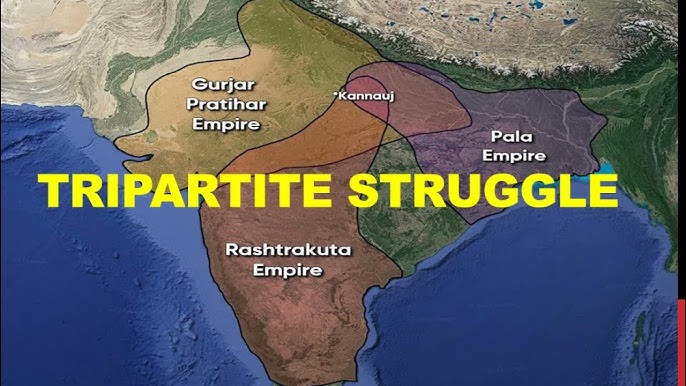
TOPIC 3.1 TRIPARTITE STRUGGLE
1 )The Palas, 2) The Gurjara – Pratihara, 3)The Rashtrakutas
1.The Palas-Bengal
1.The Palas ruled over East India for nearly 400 years, from the eighth to the twelfth centuries, and they were ardent supporters of Mahayana Buddhism.
The Pala monarchs were at war with their neighbours, the Pratiharas and the Rashtrakutas. In Bengal's history, the Pala Empire is regarded as the 'Golden Age.
Pala Dynasty ruled Bengal and Bihar for about four centuries from the middle of the 8th century AD.
2.Founded by Gopala, the rule of the dynasty underwent various vicissitudes and lasted for eighteen generations of kings.
The reigns of dharmapala and devapala formed the period of ascendancy of the dynasty, when the dynastic rule gained firm footing in Bengal and Bihar and the Palas felt powerful enough to venture out in the political arena of northern India. Both Dharmapala and Devapala were engaged in a long drawn struggle for the possession of the madhyadesa of northern Indian empire with two other powers - the Gurjara Pratiharas of western India and the Rashtrakutas of Deccan, and they had success for a limited period. Dharmapala succeeded in placing his protege on the throne of Kanauj. Devapala also held his own against the Pratiharas.
Rulers of Pala Empire
Gopala (Reign: 750 – 770 AD)
Dharmapala (Reign: 770 – 810 AD)
Devapala (Reign: 810 – 850 AD)
Mahipala I.
Ramapala.
Madanapala (Reign: 1144 – 1162 AD)
The most glorious aspect of Pala rule was their policy of public-welfare.
3.The Pala rulers were Buddhists, but the majority of their subjects were Hindus. Dharmapala had adopted the policy of religious toleration as the state policy. He had declared that he is 'conversant with the precepts of shastras' and he made 'the castes conform to their proper tenets'. This policy was followed by his successors. There is no doubt that the Hindu gods and goddesses and the Brahmins received liberal patronage from the Pala rulers, though they themselves were devout Buddhists.
4.Buddhism spread to Tibet, Java, Sumatra and Malaysia during the Pala period. The pundits from the Buddhist Viharas of Bengal played a very significant role in the propagation and spread of Buddhism in these countries.
The brightest aspect of Pala glories was manifest in the field of different arts. Distinctive achievements are seen in the arts of architecture, terracotta, sculpture and painting. The somapura mahavihara at paharpur, a creation of Dharmapala, proudly announces the excellence of the architectural art achieved in the Pala period. It is the largest Buddhist Vihara in the Indian subcontinent and the plan of its central shrine was developed in Bengal.
5.The Palas developed Buddhist centres of learning, such as the Vikramashila and the Nalanda universities. Nalanda, considered one of the first great universities in recorded history, reached its height under the patronage of the Palas.
